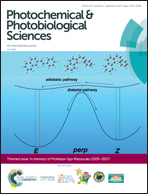Photoelectrocatalytic degradation of emerging contaminants at WO3/BiVO4 photoanodes in aqueous solution†
Abstract
WO3/BiVO4 films obtained by electrochemical deposition of BiVO4 over mesoporous WO3 were applied to the photoelectrochemical degradation of selected emerging contaminants (ketoprofen and levofloxacine) in aqueous solutions. The WO3/BiVO4 films in this work are characterized by a mesoporous morphology with a maximum photoconversion efficiency >40% extending beyond 500 nm in Na2SO4 electrolytes. Oxygen was found to be the dominant water oxidation product (ca. 90% faradaic yield) and no evidence for the photogeneration of OH radicals was obtained. Nevertheless, both 10 ppm levofloxacine and ketoprofen could be degraded at WO3/BiVO4 junctions upon a few hours of illumination under visible light. However, while levofloxacine degradation intermediates were progressively consumed by further oxidation at the WO3/BiVO4 interface, ketoprofen oxidation byproducts, being stable aromatic species, were found to be persistent in aqueous solution even after 15 hours of solar simulated illumination. This indicates that, due to the lower oxidizing power of photogenerated holes in BiVO4 and a different water oxidation mechanism, the employment of WO3/BiVO4 in photoelectrochemical environmental remediation processes is much less universal than that possible with wider band gap semiconductors such as TiO2 and WO3.

- This article is part of the themed collection: In memory of Professor Ugo Mazzucato (1929–2017)


 Please wait while we load your content...
Please wait while we load your content...